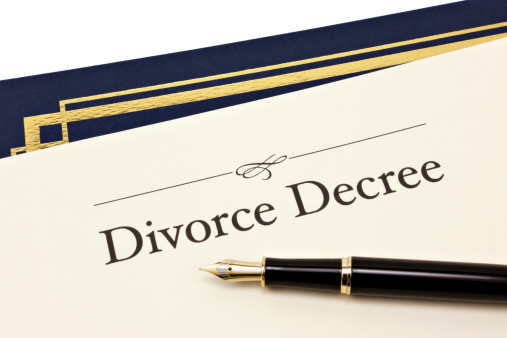
Let’s face it, it’s not easy to announce your divorce, it may in fact be what you are dreading the most, but confiding in others will help you gain the support you need to pick up the pieces. There are so many different emotions – sadness, anger, fear, guilt, etc. One of the fears is about telling your friends and family. How will they react? What will they think? Will they ask a lot of questions that you don’t know how to answer? Will they be supportive?
Some divorces come as no surprise that people saw coming and some divorces seem to come out of left field, depending on how much you and your spouse were “keeping up with appearances.” It is natural to want to keep up with appearances, after all, you may have went through months (even years) where you didn’t know if it would work out or not, and if it did you didn’t want your friends and family to dislike your spouse or think poorly of your marriage. This is not uncommon at all, it just makes initiating the conversation a bit more difficult.
Remember that ultimately your friends and family want you to be happy. Tell your immediate family and closest friends first. From there, it gets trickier to know what is the best approach to take. You probably don’t want to, nor is it healthy, to tell the story over and over, so maybe an email to extended family and friends works for you, or maybe having a specific friend and family member responsible for letting certain people know is the best method for you. Having to worry about whether you are breaking the news in the right delivery method should be the least of your concerns right now, and people ultimately need to understand that. However, because everyone seems to want to know why, it is imperative to have a brief “elevator speech” ready. This can be as simple as, “We are two good people, that are simply not good together.”
Your boss may need to know since divorce proceedings might conflict with your work schedule, but the need to tell co-workers will vary. If you aren’t close to them and normally don’t discuss your personal life then an announcement probably isn’t necessary. In today’s digital world there is also social media to consider. Don’t feel like you have to make an announcement, you can do nothing or simply change your name, eventually people will figure it out. News travels, and beyond close friends and family, you don’t own anyone an explanation.
Don’t be alarmed if some people start to distance themselves. They may also be grieving this divorce. Sometimes friends whose own marriages are struggling will separate themselves from you for fear that it may happen to them as well. It’s important to remember that divorce does not define you. Your true friends will stand by you and most likely will want to help, but they may not necessarily know how. Perhaps before you break the news to friends and family make a list of what people can help with. Whether that’s enlisting in moving help, help with the kids, emotional support, attorney recommendations, or even needing a group of friends to commit to a night out once a month. Write down anything and everything that you might think could help, and then when people ask you can let them know immediately. Helping assists people in coping and understanding, so enlisting in friends and family’s help can be beneficial to all. Friends will want to help and lend advice. Allow them to help, but please seek advice from professionals (clergy, attorneys, therapists, advisers, etc), and remember to take care of yourself emotionally and physical.
 Peace is possible though we are surrounded by conflict. In the recent words of former Secretary of State Madeleine Albright, “The world is a mess.” Messiness occurs when people are unable or unwilling to resolve differences without wars of words or weapons. This occurs not only globally but also on a personal scale. And for all the extraordinary human costs of violent conflict, the most deeply distressing is its impact on children.
Peace is possible though we are surrounded by conflict. In the recent words of former Secretary of State Madeleine Albright, “The world is a mess.” Messiness occurs when people are unable or unwilling to resolve differences without wars of words or weapons. This occurs not only globally but also on a personal scale. And for all the extraordinary human costs of violent conflict, the most deeply distressing is its impact on children.




 Almost all divorces end up in a negotiated settlement. (In most states, less than 5% of all divorces actually go to trial.) Therefore, the most important thing for couples to consider, before they start down the path toward divorce, is how to negotiate the best possible resolution to your divorce.
When I ask most clients what they want from a divorce process, they almost always talk about two things:
1.) They want a divorce that is amicable.
This makes sense. Most wise people would want an amicable divorce; either for the sake of their children, the protection of their finances, preserving their own mental health, or all three. No sane person would choose to have a messy divorce if they can avoid it.
2.) They want to feel protected.
At the same time, almost everyone wants to feel some sense of protection. They are entering into important agreements that will impact their lives and, perhaps, the lives of the children for many years. They do not want to sign an agreement that they will resent or regret.
These two negotiating goals do not need to conflict with each other.
The biggest mistake that people can make is thinking that these two goals are in conflict with each other. They want an amicable divorce but they think the need to hire an aggressive lawyer to protect their needs. Or, alternatively, they think that all lawyers will be aggressive so they avoid getting legal counsel and end up with a settlement that they regret.
Contrary to common belief, it is possible for divorcing clients to have the “best of both worlds”. This is the very reason that
Almost all divorces end up in a negotiated settlement. (In most states, less than 5% of all divorces actually go to trial.) Therefore, the most important thing for couples to consider, before they start down the path toward divorce, is how to negotiate the best possible resolution to your divorce.
When I ask most clients what they want from a divorce process, they almost always talk about two things:
1.) They want a divorce that is amicable.
This makes sense. Most wise people would want an amicable divorce; either for the sake of their children, the protection of their finances, preserving their own mental health, or all three. No sane person would choose to have a messy divorce if they can avoid it.
2.) They want to feel protected.
At the same time, almost everyone wants to feel some sense of protection. They are entering into important agreements that will impact their lives and, perhaps, the lives of the children for many years. They do not want to sign an agreement that they will resent or regret.
These two negotiating goals do not need to conflict with each other.
The biggest mistake that people can make is thinking that these two goals are in conflict with each other. They want an amicable divorce but they think the need to hire an aggressive lawyer to protect their needs. Or, alternatively, they think that all lawyers will be aggressive so they avoid getting legal counsel and end up with a settlement that they regret.
Contrary to common belief, it is possible for divorcing clients to have the “best of both worlds”. This is the very reason that 



